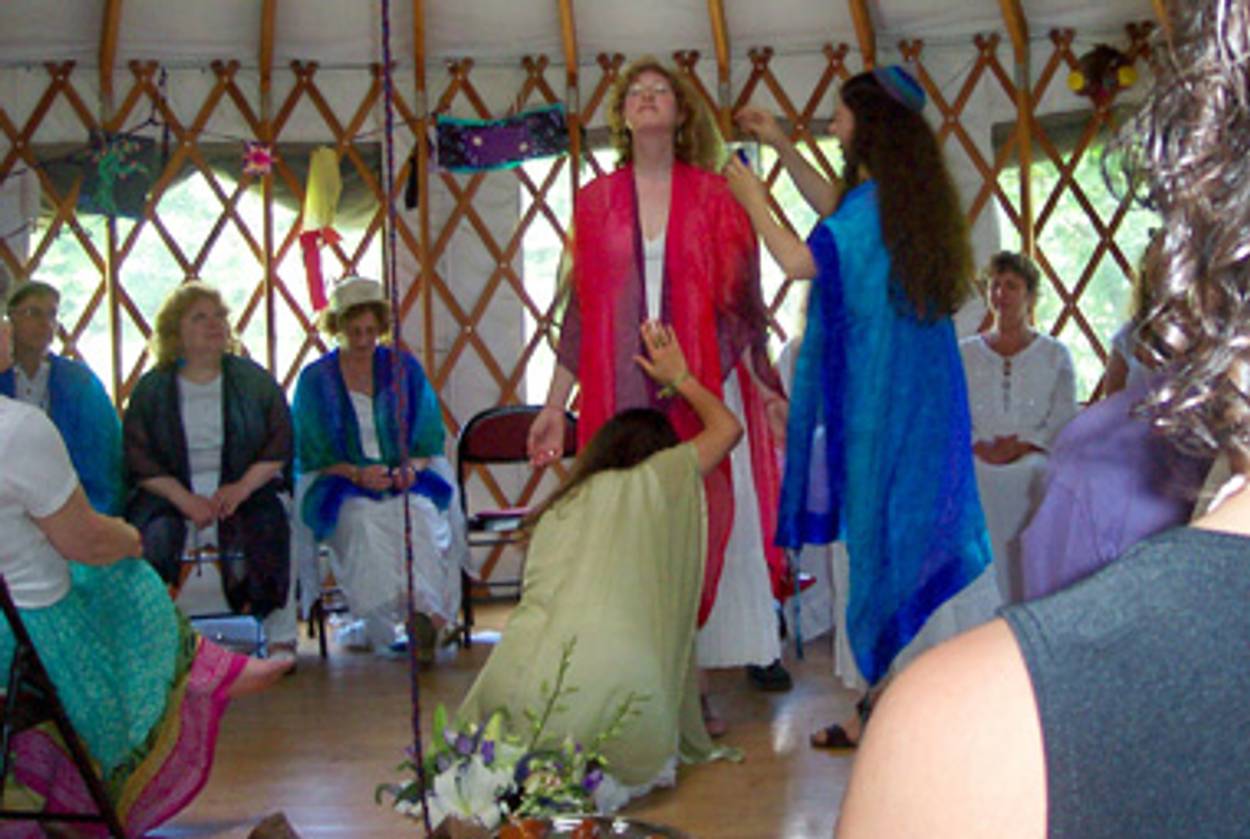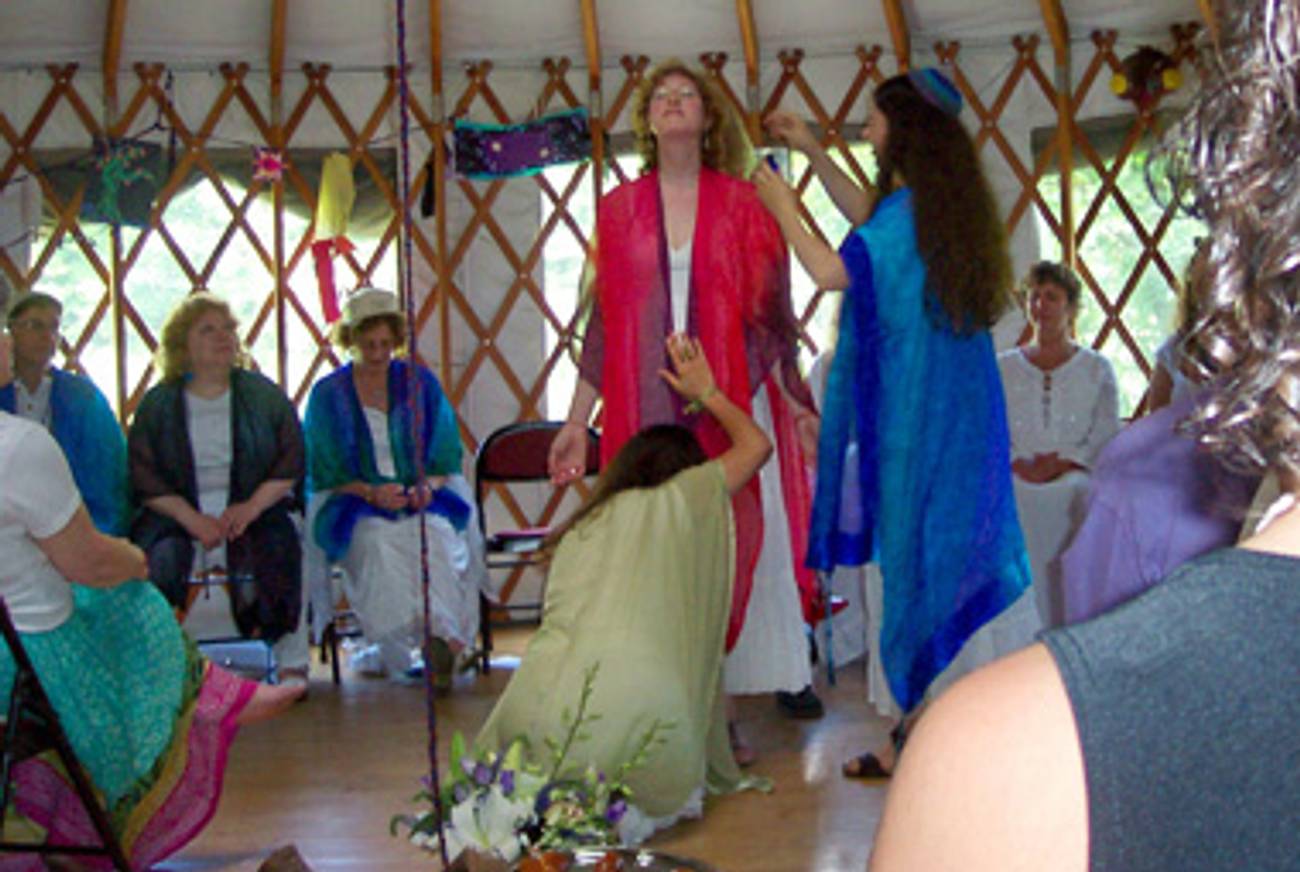Priestly Caste
There’s a growing movement of women who practice their Judaism through feminist, earth-based rituals




This month, 12 students were initiated into a class of women studying to become kohanot, or Hebrew priestesses, at a retreat center in rural Connecticut. The ordination process they’ll go through—loosely modeled on the threefold anointing of priests described in Leviticus and invoking the Shekhinah—came to Holly Shere, a folklorist, in a “dream vision” that she shared with Rabbi Jill Hammer, her co-director at Kohenet, the Hebrew Priestess Institute, which was founded in 2006.
Kohenet is part of a growing, grassroots Jewish movement to reclaim the divine feminine—female aspects of God represented in Jewish texts—and reintroduce earth-based traditions to Jewish spiritual seekers. In recent years, for example, some women have elevated Rosh Chodesh, the marking of the new moon that was celebrated as a festival in biblical times, into an important feminist holiday. And Birkat Hachama, the blessing over the sun that the Talmud instructs Jews to recite every 28 years, saw record levels of observance in April 2009, the last time it was invoked. While some earth-based ideas have seeped into the mainstream, Kohenet sees itself as part of a fringe of Judaism that “includes shamans, kabbalists, wilderness Jews, environmentalist Jews, priestesses of Shekhinah, Jewitches, [and] practitioners of Israeli nature spirituality,” according to its website.
Other groups are also reinventing traditions that they say once had a place in Judaism, from the shamanistic Walking Stick Foundation in southern California and the New Mexico-based Center for Devotional Energy and Ecstatic Practice, to the Oakland-based organization Wilderness Torah. “We teach ancient rites such as how we used to bow in prayer to the four winds,” explains Rabbi Gershon Winkler, the former ultra-Orthodox rabbi behind Walking Stick, who argues that Judaism was originally closer to Native American Shamanism than to Christianity. Rabbi Shefa Gold, who leads chanting workshops at the Center for Devotional Energy, speaks of preparing a “healing the earth ritual” for a session at a retreat center for Jewish Renewal, the new-Hasidic movement, in Boulder, Colorado. “Through the earth and fire, air and water we access the power of purification,” she says.
Kohenet too, relies on the elements for many of its rituals. Though critics assume that Kohenet is an extension of Jewish Renewal, it is also rooted in the feminine, earth-based Reclaiming tradition founded in the 1970s by Miriam Simos—a Jewish-born anarchist and self-described witch who goes by Starhawk. Her website describes the Reclaiming tradition as “an activist branch of modern Pagan religion.”
Back when Jewish Renewal and Starhawk were struggling to get off the ground, the notion of Jewish paganism was unimaginable because it defied the monotheistic core of Judaism. In recent years, though, Kohenet and other earth-based Jewish groups are challenging that monotheistic essence; in their view, Judaism and paganism can coexist. As Hammer and Shere write in an unpublished manuscript about Hebrew priestesses, Kohenet holds “a soft position with regard to monotheism.” While their work “conceives of God/dess as a unity,” they “welcome women who experience the divine as a multiplicity.” But unlike Starhawk and other Jews who became pagans, today’s earth-based Jews ground their theology explicitly in Jewish traditions and texts. “What’s new here isn’t that Jews are doing paganism,” says Jay Michaelson, a columnist for The Forward and an expert on Jewish spirituality who confesses that he has become more “pagany” over the last few years. “It’s that they’re staying Jews.”
“I don’t see how Kohenet, to judge from its website, is compatible with Jewish belief and practice,” says Rabbi Daniel Nevins, dean of the Jewish Theological Seminary’s rabbinical school, where Hammer received her ordination. From its inception, he notes, Judaism has sought to move people “away from paganism, magic, and the worship of nature.” Earth-based or pagan Jews, adds Rabbi Moshe Tendler, a dean of the seminary at Yeshiva University, are “perverts” and should be ignored. “Pagan worship by those of Jewish birth destroyed our temples and sent us into galut,” or exile, he explains.
Hammer rejects these criticisms. “Early kabbalists like the Baal Shem Tov also saw ways of finding God in the forest and fields, and they too used the language of Shekhinah,” she says. “Fear of paganism, which supposedly deifies the body and the earth in ‘bad’ ways, is fear of the body. And often, it’s fear of the female body.” She responds to questions about whether worshiping the earth is idolatry by pointing out that the word “idolaters” has been used by Jews, Christians, and Muslims throughout history to delegitimize people they don’t know much about. “Many of the customs the Bible calls ‘foreign idolatry’ are ancient Israelite customs that were abandoned by later generations,” she says.
Most women involved with Kohenet do not self-identify as pagan, according to Stephanie Melmed, a therapist based in Washington, D.C., who expects to be ordained as a kohenet next summer. Instead, they prefer neutral terms such as “earth-based.” To Melmed, who prays to El Shaddai and Eilat, names that call to mind powerful female goddesses, in addition to Shekhinah, Kohenet offers, “an earth-based, feminist reinterpretation or renarrativing of Judaism.”
More than paganism, though, Kohenet’s philosophy is best captured by the term panentheism—the belief, as Hammer and Shere put it, “in a deity that comprises all things yet is more than the sum of its parts.” It’s a theological outlook supported by Rabbi Arthur Green, rector at the Hebrew College rabbinical school outside of Boston, who writes in his new book Radical Judaism that “the time has arrived for Jewish panentheism to step out of the closet.” Green also sees Kohenet as an important step for Jewish feminism. “Jewish women’s religious creativity was so deeply squashed for so many centuries that it now bursts forth with tremendous vigor,” he wrote in an email. “Should we expect that every form of this outburst would be to my androcentric, neo-traditionalist taste? Hardly! But the release of that creative energy is such a blessing that I’m more than willing to put up with a lot that I can’t immediately embrace.”
The idea of becoming a priestess first came to Hammer in 2001, just before she was ordained. As a rabbinical student, her “fascination with the wild side of feminine deity stayed underground,” she wrote in the essay collection New Jewish Feminism. But she was enthralled by “kabbalists in their secret circles whispering the name of Immah Ilaah, the Divine Mother” and loved engaging in new moon rituals, when she would pray to Shekhinah. She was about to become a rabbi, she says, but she felt like a priestess.
Then, in late 2005, Jay Michaelson introduced Hammer to Holly Shere, who had studied priestesses in Brazil as a graduate student and was also interested in training Jewish women “to priestess.” Disillusioned by what she calls “the patriarchy, hierarchy, and the disembodiment” of mainstream Jewish practice, Shere, like Hammer, wanted to build a new kind of Judaism. “It was a thunderbolt when we met,” says Hammer. “Within an hour of speaking on the phone we decided to create this program and to call it Kohenet.” Kohenet held its first session in 2006.
Through Kohenet, Hammer and Shere want to bestow women with roles of spiritual leadership. “Women were important spiritual practitioners in the ancient world, but their roles were marginalized as Judaism became more monolithic,” she says. She cites Miriam, described in Exodus dancing with a timbrel—a popular ritualistic instrument among near eastern priestesses—as perhaps the Biblical character who most resembles a priestess.
Hammer is not sure what role, if any, kohanot will play in Jewish communities, and she prefers to leave it her students to find their place as Jewish clergy. “We’re not as learned as rabbis are in Torah and Talmud—what I call the writings of men,” says Yocheved Landsman, of Boulder, Colorado, who was ordained in Kohenet’s first graduating class last year. On the other hand, she explains, kohanot, like rabbis, lead life cycle rituals; Landsman has officiated at four weddings in Colorado—all of them interfaith—and has also helped out with funerals and baby-namings. Similarly, Ketzirah Lesser, a kohenet in Washington, D.C., offers services ranging from home cleansings to vigils for the dying. In spite of the good works, she and her peers have a way to go to gain a foothold in Jewish communities. When she told congregants at a mainstream synagogue that she was a priestess, one of them responded: “a princess?”
Whether earth-based Judaism will ever become mainstream remains to be seen, but there’s no doubt that “pagany” elements are gradually seeping in, says The Forward’s Jay Michaelson. “I’ve been to mainstream synagogues that are enthusiastically doing that ritual where you beat the willows on the ground on Sukkot,” he says. “If that’s not paganism I don’t know what is. Any pagan would be quite happy doing that.”
Jeremy Gillick is a doctoral student in history at the University of California, Davis. His writing has appeared in The Forward, Moment Magazine, and London’s Jewish Chronicle.
Jeremy Gillick is a doctoral student in history at the University of California, Davis. His writing has appeared in The Forward, Moment Magazine, and London’s Jewish Chronicle.